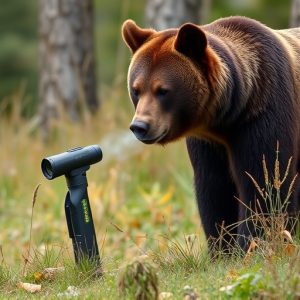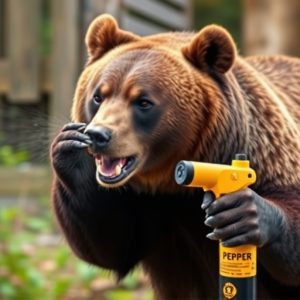Mastering Bear Spray Cloud Dispersal Range for Wilderness Safety
Understanding the Bear Spray Cloud Dispersal Range (20-30 feet or 6-9 meters) is crucial for effecti…….
Understanding the Bear Spray Cloud Dispersal Range (20-30 feet or 6-9 meters) is crucial for effective bear defense. Proper application involves aiming at the bear's face and eyes, creating a temporary irritant cloud that disables the animal. Key factors affecting dispersal include wind direction (tailwinds extend reach, headwinds reduce effectiveness), product quality, user technique, weather conditions (humidity, cold), and terrain. Effective use of bear spray, combined with noise making and habitat avoidance, offers vital time to escape or reassess during potential encounters. Always follow manufacturer instructions based on environmental factors for optimal results.
“Navigating the wilderness requires preparation, especially when facing potential bear encounters. Bear spray has emerged as a crucial defense mechanism, offering a non-lethal deterrent for both humans and bears. This article delves into the science behind bear spray cloud dispersal range, exploring factors that influence its efficacy. We’ll guide you through understanding the optimal usage of this powerful tool, ensuring your safety in various outdoor scenarios.”
- Understanding Bear Spray Cloud Dispersal Range: What You Need to Know
- Factors Affecting Bear Spray Efficacy and Range
- Best Practices for Using Wilderness Bear Encounter Defense Spray
Understanding Bear Spray Cloud Dispersal Range: What You Need to Know
When considering bear spray as a defense mechanism, understanding the Bear Spray Cloud Dispersal Range is crucial for effective use. The range varies among brands and weather conditions but generally averages between 20-30 feet (6-9 meters). This means that proper application requires you to be within this distance of an approaching bear to create an effective barrier.
Keep in mind that the spray forms a cloud, not a direct stream. Aiming for the bear’s face and eyes is key, as the irritants will temporarily incapacitate it, giving you valuable time to escape. Be aware that wind direction can significantly impact the dispersal range; a tailwind can carry the spray further, while a headwind may reduce its effectiveness.
Factors Affecting Bear Spray Efficacy and Range
The effectiveness of bear spray, or pepper spray designed for wildlife encounters, is influenced by several key factors. One of the primary considerations is the bear spray cloud dispersal range. This refers to the distance at which the spray can reach and remain effective against an attacking bear. Effective range varies greatly depending on the product, user technique, weather conditions, and terrain. For instance, some high-quality bear sprays boast a claimed range of up to 30 feet (9 meters), while others may only achieve around 15 feet (4.5 meters). Even within the same brand, different formulations or can sizes might offer slightly varying ranges.
Weather plays a significant role in bear spray performance as well. In humid conditions, the spray cloud can dissipate faster due to evaporation, reducing its effectiveness and range. Conversely, cold weather may cause some sprays to become less potent if they solidify. Additionally, wind direction and strength can impact how the spray disperses, potentially blowing it back towards the user or spreading it widely, making it less focused on the target bear. Understanding these factors is crucial for users to make informed decisions when choosing and using bear defense spray in various environments.
Best Practices for Using Wilderness Bear Encounter Defense Spray
When it comes to best practices for using wilderness bear encounter defense spray, understanding its cloud dispersal range and proper application techniques is key. Bear spray is designed to create a disorienting cloud that can deter aggressive bears, providing precious time for escape or reassessment of the situation. For optimal effectiveness, users should aim for the face and eyes of the bear, similar to how pepper spray is deployed against human aggressors. This direct targeting ensures maximum disruption of the bear’s senses.
The range of bear spray varies based on factors like weather conditions and terrain, but generally, it can reach up to 30 feet (9 meters). It’s crucial to follow the instructions provided by the manufacturer for optimal dispersal. Users should also be aware that bear spray is not a guarantee against attacks; it’s one tool in a multi-layered defense strategy that includes making noise, avoiding known bear habitats, and carrying other deterrents like bells or whistles.
Understanding the bear spray cloud dispersal range is key to ensuring your safety during encounters in the wilderness. By knowing how far and in which conditions bear spray can effectively deter bears, you can make informed decisions while hiking or camping in bear country. Factors like distance, wind direction, and terrain play significant roles in determining the spray’s reach. Following best practices for usage, including proper application techniques, will maximize its effectiveness. Remember, while bear spray is a valuable tool, it should be used as a last resort. Always prioritize prevention through noise making, maintaining distance, and knowing bear behavior to avoid dangerous situations.


